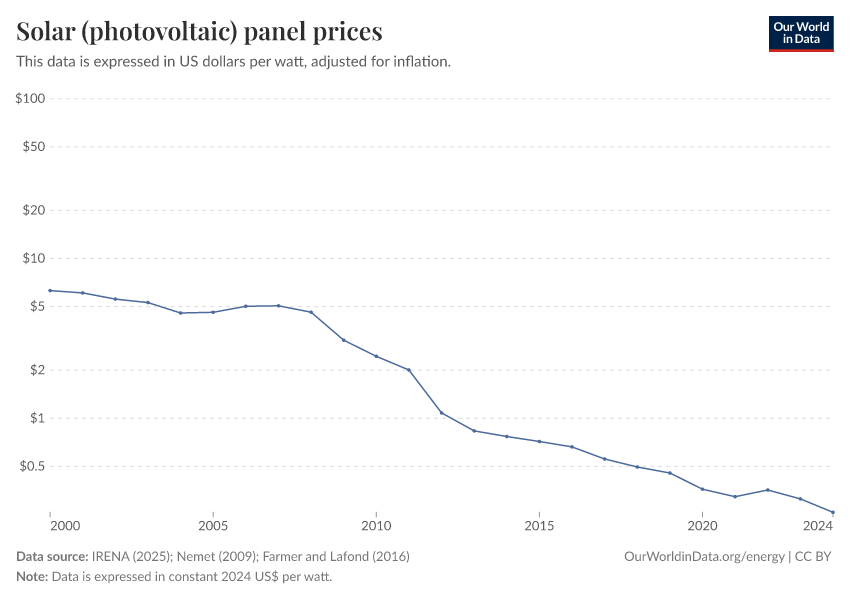Solar photovoltaic module price

What you should know about this indicator
IRENA presents solar photovoltaic module prices for a number of different technologies. Here we use the average yearly price for technologies 'Thin film a-Si/u-Si or Global Price Index (from Q4 2013)'.
What you should know about this indicator
IRENA presents solar photovoltaic module prices for a number of different technologies. Here we use the average yearly price for technologies 'Thin film a-Si/u-Si or Global Price Index (from Q4 2013)'.
Sources and processing
This data is based on the following sources
How we process data at Our World in Data
All data and visualizations on Our World in Data rely on data sourced from one or several original data providers. Preparing this original data involves several processing steps. Depending on the data, this can include standardizing country names and world region definitions, converting units, calculating derived indicators such as per capita measures, as well as adding or adapting metadata such as the name or the description given to an indicator.
At the link below you can find a detailed description of the structure of our data pipeline, including links to all the code used to prepare data across Our World in Data.
Notes on our processing step for this indicator
- Photovoltaic cost data between 1975 and 2003 has been taken from Nemet (2009), between 2004 and 2009 from Farmer & Lafond (2016), and since 2010 from IRENA.
- Prices from Nemet (2009) and Farmer & Lafond (2016) have been converted to 2024 US$ using the US GDP deflator, to account for the effects of inflation. The deflator data is available from the World Bank World Development Indicators.
Reuse this work
- All data produced by third-party providers and made available by Our World in Data are subject to the license terms from the original providers. Our work would not be possible without the data providers we rely on, so we ask you to always cite them appropriately (see below). This is crucial to allow data providers to continue doing their work, enhancing, maintaining and updating valuable data.
- All data, visualizations, and code produced by Our World in Data are completely open access under the Creative Commons BY license. You have the permission to use, distribute, and reproduce these in any medium, provided the source and authors are credited.
Citations
How to cite this page
To cite this page overall, including any descriptions, FAQs or explanations of the data authored by Our World in Data, please use the following citation:
“Data Page: Solar photovoltaic module price”, part of the following publication: Hannah Ritchie, Pablo Rosado, and Max Roser (2023) - “Energy”. Data adapted from IRENA, Nemet, Farmer and Lafond. Retrieved from https://archive.ourworldindata.org/20250909-093708/grapher/solar-pv-prices.html [online resource] (archived on September 9, 2025).How to cite this data
In-line citationIf you have limited space (e.g. in data visualizations), you can use this abbreviated in-line citation:
IRENA (2025); Nemet (2009); Farmer and Lafond (2016) – with major processing by Our World in DataFull citation
IRENA (2025); Nemet (2009); Farmer and Lafond (2016) – with major processing by Our World in Data. “Solar photovoltaic module price” [dataset]. IRENA, “Renewable Power Generation Costs in 2024”; Nemet, “Interim monitoring of cost dynamics for publicly supported energy technologies”; Farmer and Lafond, “How predictable is technological progress?” [original data]. Retrieved December 31, 2025 from https://archive.ourworldindata.org/20250909-093708/grapher/solar-pv-prices.html (archived on September 9, 2025).